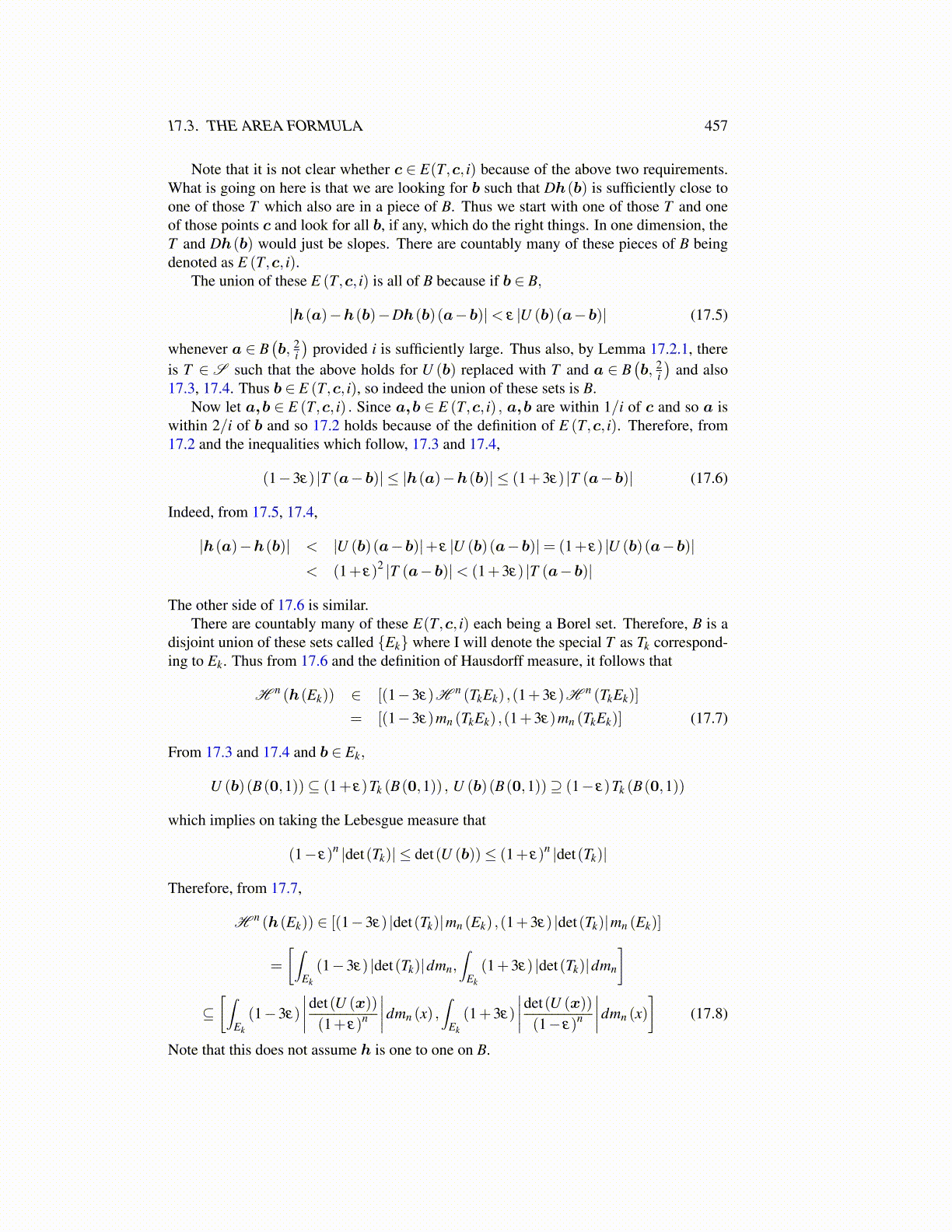
17.3. THE AREA FORMULA 457
Note that it is not clear whether c ∈ E(T,c, i) because of the above two requirements.What is going on here is that we are looking for b such that Dh(b) is sufficiently close toone of those T which also are in a piece of B. Thus we start with one of those T and oneof those points c and look for all b, if any, which do the right things. In one dimension, theT and Dh(b) would just be slopes. There are countably many of these pieces of B beingdenoted as E (T,c, i).
The union of these E (T,c, i) is all of B because if b ∈ B,
|h(a)−h(b)−Dh(b)(a−b)|< ε |U (b)(a−b)| (17.5)
whenever a ∈ B(b, 2
i
)provided i is sufficiently large. Thus also, by Lemma 17.2.1, there
is T ∈S such that the above holds for U (b) replaced with T and a ∈ B(b, 2
i
)and also
17.3, 17.4. Thus b ∈ E (T,c, i), so indeed the union of these sets is B.Now let a,b ∈ E (T,c, i) . Since a,b ∈ E (T,c, i) , a,b are within 1/i of c and so a is
within 2/i of b and so 17.2 holds because of the definition of E (T,c, i). Therefore, from17.2 and the inequalities which follow, 17.3 and 17.4,
(1−3ε) |T (a−b)| ≤ |h(a)−h(b)| ≤ (1+3ε) |T (a−b)| (17.6)
Indeed, from 17.5, 17.4,
|h(a)−h(b)| < |U (b)(a−b)|+ ε |U (b)(a−b)|= (1+ ε) |U (b)(a−b)|< (1+ ε)2 |T (a−b)|< (1+3ε) |T (a−b)|
The other side of 17.6 is similar.There are countably many of these E(T,c, i) each being a Borel set. Therefore, B is a
disjoint union of these sets called {Ek} where I will denote the special T as Tk correspond-ing to Ek. Thus from 17.6 and the definition of Hausdorff measure, it follows that
H n (h(Ek)) ∈ [(1−3ε)H n (TkEk) ,(1+3ε)H n (TkEk)]
= [(1−3ε)mn (TkEk) ,(1+3ε)mn (TkEk)] (17.7)
From 17.3 and 17.4 and b ∈ Ek,
U (b)(B(0,1))⊆ (1+ ε)Tk (B(0,1)) , U (b)(B(0,1))⊇ (1− ε)Tk (B(0,1))
which implies on taking the Lebesgue measure that
(1− ε)n |det(Tk)| ≤ det(U (b))≤ (1+ ε)n |det(Tk)|
Therefore, from 17.7,
H n (h(Ek)) ∈ [(1−3ε) |det(Tk)|mn (Ek) ,(1+3ε) |det(Tk)|mn (Ek)]
=
[∫Ek
(1−3ε) |det(Tk)|dmn,∫
Ek
(1+3ε) |det(Tk)|dmn
]⊆[∫
Ek
(1−3ε)
∣∣∣∣det(U (x))
(1+ ε)n
∣∣∣∣dmn (x) ,∫
Ek
(1+3ε)
∣∣∣∣det(U (x))
(1− ε)n
∣∣∣∣dmn (x)]
(17.8)
Note that this does not assume h is one to one on B.